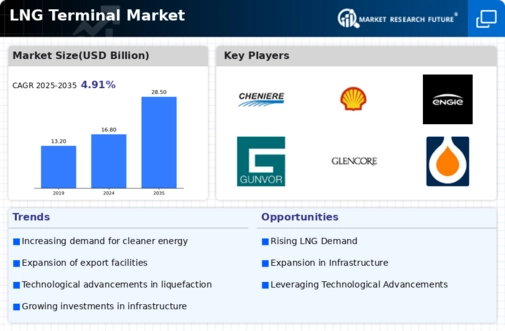Market Growth Projections
The Global LNG Terminal Market Industry is projected to experience substantial growth, with estimates indicating a market size of 16.8 USD Billion in 2024 and a potential increase to 28.5 USD Billion by 2035. This growth trajectory suggests a compound annual growth rate (CAGR) of 4.91% from 2025 to 2035, driven by various factors such as rising demand for natural gas, infrastructure development, and technological advancements. The market's expansion reflects the increasing importance of LNG in the global energy landscape, as countries seek to diversify their energy portfolios and enhance energy security.
Increasing Demand for Natural Gas
The Global LNG Terminal Market Industry experiences a surge in demand for natural gas as countries transition towards cleaner energy sources. This shift is driven by the need to reduce carbon emissions and reliance on coal. In 2024, the market is projected to reach 16.8 USD Billion, reflecting the growing preference for LNG as a more environmentally friendly alternative. As nations implement stricter regulations on emissions, the demand for LNG terminals is likely to increase, facilitating the import and export of liquefied natural gas. This trend indicates a robust growth trajectory for the industry, with a projected CAGR of 4.91% from 2025 to 2035.
Infrastructure Development Initiatives
Governments worldwide are investing in infrastructure development to enhance energy security and diversify energy sources. The Global LNG Terminal Market Industry benefits from these initiatives, as new terminals are constructed to accommodate rising demand. For instance, several countries are expanding their LNG terminal capacities to support both domestic consumption and international trade. This infrastructure expansion is crucial for meeting the projected market growth, with estimates suggesting the market could reach 28.5 USD Billion by 2035. Enhanced infrastructure not only supports LNG supply chains but also fosters economic growth in regions where these terminals are established.
Geopolitical Factors and Energy Security
Geopolitical dynamics significantly influence the Global LNG Terminal Market Industry, as countries seek to secure their energy supplies amidst fluctuating global markets. The need for energy independence drives nations to invest in LNG terminals, allowing them to diversify their energy sources and reduce vulnerability to supply disruptions. For example, countries in Europe are increasingly turning to LNG imports to mitigate reliance on traditional pipeline supplies. This strategic shift not only enhances energy security but also stimulates investments in terminal infrastructure, contributing to the overall growth of the market.
Technological Advancements in LNG Processing
Technological innovations in LNG processing and transportation are pivotal for the Global LNG Terminal Market Industry. Advances in liquefaction technology, storage solutions, and regasification processes enhance the efficiency and safety of LNG operations. These improvements reduce operational costs and increase the competitiveness of LNG as an energy source. Moreover, the integration of digital technologies, such as IoT and AI, optimizes terminal operations, leading to better resource management. As these technologies evolve, they are expected to drive further investments in LNG terminals, thereby supporting the industry's growth trajectory in the coming years.
Environmental Regulations and Sustainability Goals
The Global LNG Terminal Market Industry is shaped by stringent environmental regulations and sustainability goals set by governments and international organizations. These regulations promote the adoption of cleaner energy sources, including LNG, as part of broader climate action initiatives. As countries commit to reducing greenhouse gas emissions, the demand for LNG terminals is likely to rise, facilitating the transition to a low-carbon economy. This regulatory landscape encourages investments in LNG infrastructure, positioning the industry for sustained growth as it aligns with global sustainability objectives.





















